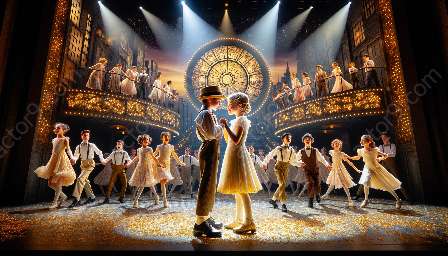Adapting choreography for different venues and stages in Broadway touring productions requires careful planning, creativity, and precision. This process involves a combination of artistic vision, technical expertise, and adaptability to ensure that the original choreography maintains its integrity while being tailored to the unique characteristics of each venue and stage. In this topic cluster, we will delve into the intricacies of adapting choreography for Broadway touring productions, explore the roles and responsibilities of Broadway backup dancers, and gain a deeper understanding of the world of Broadway and musical theater.
Adapting Choreography for Different Venues and Stages
When a Broadway production embarks on a tour, the choreography must be adapted to suit a variety of venues and stages. This process begins with a comprehensive assessment of the new performance spaces, taking into account factors such as stage dimensions, configurations, and technical capabilities. The choreographer, along with the production team, works closely with stage managers and technical crews to understand the logistics of each venue and develop creative solutions to effectively showcase the choreography.
Adapting choreography for different stages also involves considering the audience's perspective and experience. The choreographer must ensure that the dancers' movements and formations remain impactful and visually captivating, regardless of the size or layout of the stage. This may involve adjustments in spacing, timing, and even the choreographic patterns to optimize the overall visual effect from the audience's viewpoint.
Furthermore, the choreographer must take into account the acoustic and visual characteristics of each venue, as they can significantly influence the presentation of the choreography. For instance, a larger theater with a more expansive stage may necessitate expanded movements and larger-scale patterns to fill the space effectively. On the other hand, a smaller, more intimate venue may require more nuanced and detailed choreographic adjustments to maintain the intimacy and connection with the audience.
Technical Considerations and Flexibility
Adapting choreography for different venues also involves technical considerations, such as lighting, sound, and special effects. The choreographer collaborates closely with the production's technical teams to ensure that the choreography aligns seamlessly with the overall technical design of each performance space. This can include adjustments in lighting cues, sound levels, and the utilization of stage effects to complement and enhance the choreographic elements.
Another essential aspect of adapting choreography for Broadway touring productions is the dancers' adaptability and flexibility. Dancers must be able to quickly adjust to new stage dimensions, surfaces, and technical setups. This requires extensive rehearsals and a strong understanding of spatial awareness, as dancers need to adapt their movements to the unique characteristics of each stage while maintaining precision and synchronization with their fellow performers.
Furthermore, the choreographer and the dance captains play a pivotal role in overseeing the adaptation process, ensuring that the dancers remain in sync with the adapted choreography and consistently deliver high-quality performances across different venues.
Broadway Backup Dancers: Roles and Responsibilities
Within the realm of Broadway touring productions, backup dancers play an integral role in bringing the choreography to life and enhancing the overall storytelling of the production. The roles and responsibilities of backup dancers encompass a wide range of duties that contribute to the seamless execution of the choreography and the overall performance.
Backup dancers are not merely supporting performers; they are essential pillars of the production, providing depth, energy, and precision to the choreographic sequences. Their responsibilities include mastering intricate choreography, maintaining consistent energy and expression throughout the performances, and seamlessly integrating with the principal performers and the ensemble to create a cohesive and visually stunning stage presence.
Additionally, backup dancers are often required to embody various characters and personas as part of the storytelling process, enhancing the narrative through their movements, expressions, and interactions with the principal cast. This demands versatility, emotional depth, and a keen understanding of character development, allowing backup dancers to enrich the production with their individual interpretations and contributions.
Furthermore, backup dancers play a crucial role in maintaining the integrity and continuity of the choreography during the adaptation process. Their ability to adapt to different venues and stages, while upholding the precision and dynamics of the choreography, is essential in ensuring that the artistic vision of the production remains consistent and impactful across various touring locations.
Broadway and Musical Theater
Broadway and musical theater represent a rich tapestry of artistic expression, storytelling, and performance excellence. The world of Broadway encompasses a diverse range of productions, spanning from classic musicals to contemporary theatrical experiences, each with its own distinct charm and allure.
At the heart of Broadway and musical theater are the captivating performances that transfix audiences and transport them into enchanting worlds of music, dance, and drama. The fusion of live music, spectacular choreography, and compelling narratives creates an immersive and enthralling experience that resonates with theater enthusiasts and casual spectators alike.
Moreover, Broadway touring productions offer the opportunity to bring the magic of theater to audiences beyond the confines of New York City, allowing theater enthusiasts around the world to experience the splendor of Broadway's finest productions in their own communities. This expansion of the theatrical reach not only enriches the cultural landscape but also fosters a deeper appreciation for the artistry and craftsmanship that define Broadway and musical theater.
In conclusion, the process of adapting choreography for different venues and stages in Broadway touring productions is an intricate and dynamic endeavor that encapsulates the collaborative efforts of choreographers, dancers, and production teams. By seamlessly integrating technical considerations, artistic vision, and the adaptability of performers, Broadway productions can transcend the confines of traditional stages and captivate audiences across diverse performance spaces. Additionally, the roles and responsibilities of backup dancers within this context underscore the significance of their contributions to the overall success of the production, adding depth, vibrancy, and precision to the choreographic landscape of Broadway and musical theater.



































